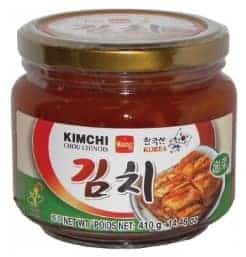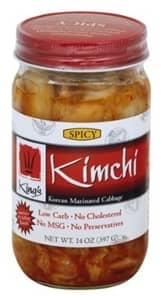Kimchi, a classic Korean cuisine, is a traditional side dish made up of salted and fermented veggies, such as Korean radish and napa cabbage, and a wide variety of seasonings like ginger, garlic, scallions, gochugaru (chili powder), and jeotgal.1-3
Is it vegan? Like with many food products, some kimchi is vegan, but most recipes/formulations tend to be non-vegan. The two primary ingredients include vegetables and seasonings. It’s the latter (seasonings) that can be problematic because some of the most common flavorings used for kimchi are animal-derived.
Vegan-friendly ingredients include:2,4,5
- Gochugaru (chili powder)
- Scallions
- Garlic
- Ginger
Non-vegan ingredients, as you’ll see, are mostly derived from marine life.
Non-Vegan Ingredients Potentially Present in Kimchi
Again, fermented veggies make up the bulk of kimchi ingredients. Spices and salt, such as brining salt (salt with a larger grain size compared to common kitchen salt) are also used.
The latter is used mostly for initial salting of the vegetables. Minimally processed salt helps to develop flavors when used in fermented foods.6
Certains seasonings can spell trouble for vegans and vegetarians, as some of the most commonly used seasonings in kimchi are derived from seafood. Most fall under the category of jeotgal.
Jeotgal
Jeotgal is a term for salted seafood and makes up a category of salted preserved food products made with shrimps, fish, roe (fish eggs), and bivalves such as clams and oysters. A clear, broth-like liquid is also very common.2,4,5
Salted shrimp (saeu-jeot) or croaker (jogi-jeot) is also common in certain regions where the dish is widely consumed.
In South Korea, a strongly-flavored jeotgal—salted anchovies (myeolchi-jeot) and salted hairtail (galchi-jeot)—is commonly consumed. Raw seafood called daegu-agami-jeot (or salted cod gills) is common in certain regions of South Korea.5
Seafood (General)
In commercial kimchi, manufacturers won’t get so fancy as to use fermented veggies. Rather, seafood will take the form of dried powders or pastes.
For example, Nongshim’s Bowl Noodle Soup Spicy Kimchi Flavor (yes, that’s the name of the product) contains the usual ingredients (enriched wheat flour, oils, and starches, etc.), and shrimp obscured in “dried kimchi flakes” which is an ingredient that seems to be a combination of salts, spices, and seafood.7
This product doesn’t stop there but also contains anchovy extract, beef bone extract (didn’t know that was a thing), beef extract and beef fat, non-dairy lactic acid, even more shrimp, and sand lance (a type of fish).6
At least, the lactic acid was non-dairy.
Fish Sauce
Fish sauce is a very common non-vegan condiment used to flavor kimchi.8
That’s not to say you can’t find some vegan “fish sauce” on the market. But, non-vegan versions of the product (i.e. real fish sauce) is the default. I wrote an entire article on the vegan status of fish sauce you can check out here.*
For example, Frieda’s Hot & Spicy Kimchi Sauce contains napa cabbage, daikon, red pepper, ginger, garlic, sugar and salt, boiled shrimp, onion, water, and fish sauce.9
Beef
Beef is a fairly common ingredient in kimchi.
Keep a lookout for beef stock too, as it’s a common ingredient in commercial kimchi. For example, Mother in Laws Kimchi contains daikon radish, chili pepper, salt, raw sugar, onion and garlic, beef stock, and salted shrimp.10
Among other ingredients, Kimchi Ramyun (a ramen noodle version) contains enriched wheat flour, palm oil, various starches (potato, etc.), salt, anchovy extract, black pepper, various vegetables (cabbage, carrots, green onions, etc.), cellulose, citric acid, corn syrup, dextrose, various additives (disodium guanylate, inosinate, and succinate), wheat protein, garlic, ginger, gum arabic, soy protein, and beef extract, beef fat, and beef stock.11
Commercial Vegan Kimchi
A lot of folks are wondering about kimchi for the purposes of ordering it in restaurants. Below are examples of commercial kimchi products that you can buy in supermarkets and Asian food stores.
But, the examples should give you an idea of the types of ingredients that are likely to be in the kimchi served at Korean restaurants.
The main difference is that kimchi served in restaurants will probably be made with fresh ingredients. To know if your favorite restaurant serves kimchi that’s vegan-friendly, you’ll need to reach out to the restaurant staff or visit the website—if the establishment has nutritional info on their site.
Wang Napa Cabbage Kimchi

This is one of the rare products containing a kimchi veggie/spice mix without fish sauce or seafood of any kind.
This product contains pickled Chinese cabbage, carrot, d-sorbitol, sugar, red pepper powder, garlic, green onion, onion (regular), sodium l-glutamate, ginger, xanthan gum, vitamin C, sodium 5-inosinate, and water.12
You may have noticed the presence of xanthan gum. This ingredient has been somewhat controversial in the community over the years, but most vegans don’t avoid consuming the additive because it’s usually derived from bacteria cultivated on simple sugars other than lactose.
Again, it’s considered suitable for vegans by most standards.13
King’s Kimchi Korean Marinated Spicy Cabbage

This is just the cabbage, but if you’re making your own, this could be a useful product.
The only ingredients are napa cabbage, green onion, garlic, hot pepper, salt, sugar, ginger, and paprika.14
That’s it for the vegan status of kimchi. Thanks for reading.
You may also want to check out the following related articles:
References
- Lee, Young C. (1991). “Kimchi: The famous fermented vegetable product in Korea”. Food Reviews International. 7 (4): 399–415.
- Kimchi. The Britannica – https://www.britannica.com/topic/kimchi
- Chin, Mei (14 October 2009). “The Art of Kimchi”. Saveur.
- The Art Of Kimchi. http://www.saveur.com/article/Kitchen/The-Art-of-Kimchi
- 김치. http://www.doopedia.co.kr/doopedia/master/master.do?_method=view&MAS_IDX=101013000729133
- Shaking Up Salt. http://modernfarmer.com/2014/12/shaking-salt/
- Nongshim Bowl Noodle Soup Spicy Kimchi Flavor, 4 / 3.03 Oz Packages. Tara – https://www.walmart.com/ip/Nongshim-Bowl-Noodle-Soup-Spicy-Kimchi-Flavor-4-3-03-oz-packages/54889613
- Understanding and Making Kimchi. http://farmtotable.colostate.edu/prepare-ferment/kimchi.pdf
- Kimchi Hot 14oz. https://www.walmart.com/ip/Kimchi-Hot-14oz/163612052
- Milkimchi Mother in Laws Kimchi, 16 Oz. Meg – https://www.walmart.com/ip/MILKimchi-Mother-in-Laws-Kimchi-16-oz/178117215
- Kimchi Ramyun Multipak, 16.8 Oz. Menezzie – https://www.walmart.com/ip/Kimchi-Ramyun-Multipak-16-8-oz/153497236
- Wang – Napa Cabbage Kimchi (韓國泡菜) – Wai Yee Hong Wai Hong – https://shop.waiyeehong.com/food-ingredients/preserves-pickles/preserved-vegetables/kimchi
- The Vegetarian Resource Group Blog. https://www.vrg.org/blog/2018/06/28/xanthan-gum-is-vegan-no-egg-whites/
- King’s Kimchi Korean Marinated Spicy Cabbage 14 Oz. Jar. Grayden- Scott- RicketyDick – https://www.walmart.com/ip/King-s-Kimchi-Korean-Marinated-Spicy-Cabbage-14-oz-Jar/15570967

